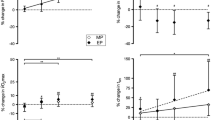Summary
Epoetin (recombinant human erythropoietin) is used by some endurance athletes to increase oxygen transport and aerobic power in an attempt to improve endurance capacity and recovery during training and competition. Although currently on the list of banned substances issued by the medical commission of the International Olympic Committee, the use of epoetin as an ergogenic agent remains uncontrollable using classical analytical techniques. In the present paper, after subcutaneous administration of repeated high doses (200 units/kg), the pharmacokinetics of epoetin were evaluated in 18 athletes. The mean elimination half-life was 42.0 hours. The total clearance/bioavailability (F) and the volume of distribution/F averaged 0.05 L/h/kg and 2.95 L/kg, respectively. Significant changes in ferritin (fr), soluble transferrin receptor (sTfR) and ratio (sTfR/fr) were observed after administration. A population sigmoidal asymptotic maximum expected effect concentration (emax) model has been developed to assess and quantify the relationship between the changes in sTfR, fr and the ratio sTfR/fr secondary to the repeated administration of epoetin. The mean population parameters were as follows: emax: 12.6 mg/L, 44.9 µtg/Land 2313.5; the concentration producing 50% of the emax(C50): 18.3,18.1 and 37.7 IU/L; the sigmoidicity factor (gamma): 2.96, 4.17 and 5.15; and ke0 (rate constant of transfer between central and effect compartment): 1.29 × 10−3, 7.14 × 10−3 and 3.47 × 10−3/h for the 3 markers, respectively. Moreover, in this paper, we propose an appropriate statistical methodology based on the measurement of sTfR, fr and sTfR/fr from blood samples to decide if the observed values of these markers could be related, at a given probability risk, to the administration of epoetin. Values greater than 10 mg/L for sTfR and 403 for sTfR/fr indicate a probable intake of epoetin. Because of the large interindividual variability of fr, it has not been possible to define a threshold value for this parameter. The sTfR seems to be the most effective marker in doping control. An increased haematocrit with concomitant changes in sTfR and sTfR/fr values seems to supply a valuable diagnostic tool that avoids false-positive doping and allows the identification of epoetin abusers. Blood samples could be collected using capillary blood from the fingertip or earflap. These controls could be carried out during training because they are easy to perform and do not add substantially to total screening costs. At present, this is the only tool available for detecting epoetin abusers during competition.
Similar content being viewed by others
References
Berglund B, Ekblom B. Effect of recombinant human erythropoietin treatment on blood pressure and some haematological parameters in healthy males. J Int Med 1991; 229: 125–30
Ekblom B, Berglund B. Effect of erythropoietin administration on maximal aerobic power in man. Scand J Med Sci Sports 1991; 1: 88–93
Kicman AT, Cowan DA. Peptides hormones and sport: misuse and detection. Br Med Bull 1992; 48(3): 496–517
Koury MJ, Bondurant MC. The molecular mechanism of erythropoietin action. Eur J Biochem 1992; 210: 649–63
Jelkman W. Biology of erythropoietin. Clin Invest 1994; 72: S3–S10
Gareau R, Audran M, Baynes RD, et al. Erythropoietin abuse in athletes. Nature 1996; 380: 113
Souillard A, Audran M, Bressolle F, et al. Recombinant human erythropoietin and pharmacodynamic parameters in athletes. Interest of blood sampling for doping control. Br J Clin Pharmacol 1996; 42: 355–60
Flowers CH, Skikne BS, Covell AM, et al. The clinical measurement of serum transferrin receptor. J Lab Clin Med 1989; 114: 368–77
Flowers CH, Kuizon M, Beard JL, et al. A serum ferritin assay for prevalence studies of iron deficiency. Am J Hematol 1986; 23: 141–51
EM-fit, version 1.0, Bestfit, Luxembourg
Gareau R, Brisson GR, Ayotte C, et al. A possible approach to erythropoietin doping detection. In: Hemmersbach P, Birkeland KI, editors. Blood samples in doping control. Proceedings of the Second International Symposium on Drugs in Sports; 1993 Aug 29–31: Oslo. Pensumtjenest, 1994: 141–51
Wide L, Bengtsson C, Berglund B, et al. Detection in blood and urine of recombinant erythropoietin administered to healthy men. Med Sci Sports Exerc 1995; 27: 1569–76
Author information
Authors and Affiliations
Rights and permissions
About this article
Cite this article
Bressolle, F., Audran, M., Gareau, R. et al. Population Pharmacodynamics for Monitoring Epoetin in Athletes. Clin. Drug Invest. 14, 233–242 (1997). https://doi.org/10.2165/00044011-199714030-00012
Published:
Issue Date:
DOI: https://doi.org/10.2165/00044011-199714030-00012




